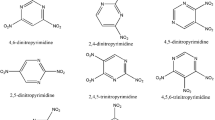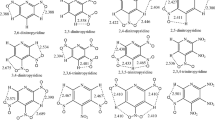Abstract
Nitro-substituted derivatives of hypoxanthine are designed by substituting the hydrogen atoms by nitro groups. The heats of formation (HOF) are calculated at the G3MP2 level to confirm the thermal stability. Also, the bond dissociation energy (BDE) accompanied by the bond order is calculated at the same level to explore kinetic stability. To evaluate the potential application as high-energy density materials, the explosive heat, the molecular density, the detonation pressure, and detonation velocity are estimated by using the Kamlet-Jacobs (K-J) equation. Furthermore, the molecular sensitivities are considered by calculating the character height (H50) and the amount of free space per molecule in the crystal lattice (ΔV). Based on our calculations, the trinitro-substituted hypoxanthine (C) is screened out as the potential high-energy density compounds for further study.

Similar content being viewed by others
References
Klapötke TM, Stierstorfer J (2008) The CN7− anion. J Am Chem Soc 131:1122–1134
Hammerl A, Klapötke TM, Nöth H, Warchhold M, Holl G, Kaiser M, Ticmanis U (2001) [N2H5]+2[N4C−NN−CN4]2−: a new high-nitrogen high-energetic material. Inorg Chem 40:3570–3575
Li B, Li L, Chen S (2019) Thermal stability and detonation character of nitro-substituted derivatives of imidazole. J Mol Model 25:298–304
Ostmark H, Langlet A, Bergman H, Wingborg N, Wellmar U, Bemm U (1998) FOX-7-a new explosive with low sensitivity and high performance. In: 11th International Symposium on Detonation, Snowmass, CO, USA
Li B, Lulin L, Yang C (2020) Theoretical study on nitroso-substituted derivatives of azetidine as potential high energy density compounds. Chin J Struct Chem 39:643–650
Christe KO, Wilson WW, Sheehy JA, Boatz JA (1999) N5+: a novel homoleptic polynitrogen ion as a high energy density material. Angew Chem Int Ed 38:2004–2009
Yan T, Sun G, Chi W, Li B, Wu H (2013) Looking for high energy density compounds among polynitraminepurines. J Mol Model 19:3491–3499
Politzer P, Murray JS (2015) Impact sensitivity and the maximum heat of detonation. J Mol Model 21:262
Nagao H, Nishizawa H, Tanaka Y, Fukata T, Mizushima T, Furuno M, Bamba T, Tsushima Y, Fujishima Y, Kita S (2018) Hypoxanthine secretion from human adipose tissue and its increase in hypoxia. Obesity 26:1168–1178
Al Balushi HWM, Rees DC, Brewin JN, Hannemann A, Gibson JS (2018) The effect of xanthine oxidase and hypoxanthine on the permeability of red cells from patients with sickle cell anemia. Physiol Rep 6
Lee JS, Wang RX, Alexeev EE, Lanis JM, Battista KD, Glover LE, Colgan SP (2018) Hypoxanthine is a checkpoint stress metabolite in colonic epithelial energy modulation and barrier function. J Biol Chem 293:6039–6051
Frisch MJ, Trucks GW, Schlegel HB, Scuseria GE, Robb MA, Cheeseman JR, Scalmani G, Barone V, Mennucci B, Petersson GA, Nakatsuji H, Caricato M, Li X, Hratchian HP, Izmaylov AF, Bloino J, Zheng G, Sonnenberg JL, Hada M, Ehara M, Toyota K, Fukuda R, Hasegawa J, Ishida M, Nakajima T, Honda Y, Kitao O, Nakai H, Vreven T, Montgomery JA, Jr., Peralta JE, Ogliaro F, Bearpark M, Heyd JJ, Brothers E, Kudin KN, Staroverov VN, Kobayashi R, Normand J, Raghavachari K, Rendell A, Burant JC, Iyengar SS, Tomasi J, Cossi M, Rega N, Millam JM, Klene M, Knox JE, Cross JB, Bakken V, Adamo C, Jaramillo J, Gomperts R, Stratmann RE, Yazyev O, Austin AJ, Cammi R, Pomelli C, Ochterski JW, Martin RL, Morokuma K, Zakrzewski VG, Voth GA, Salvador P, Dannenberg JJ, Dapprich S, Daniels AD, Farkas O, Foresman JB, Ortiz JV, Cioslowski J, Fox DJ (2009) Gaussian 09, revision a.1, Wallingford, CT
Curtiss LA, Redfern PC, Raghavachari K, Rassolov V, Pople JA (1999) Gaussian-3 theory using reduced Mo/ller-Plesset order. J Chem Phys 110:4703–4709
Bak KL, Jørgensen P, Olsen J, Helgaker T, Klopper W (2000) Accuracy of atomization energies and reaction enthalpies in standard and extrapolated electronic wave function/basis set calculations. J Chem Phys 112:9229–9242
Su Y-Q, Wang Y, Liu J-X, Filot IAW, Alexopoulos K, Zhang L, Muravev V, Zijlstra B, Vlachos DG, Hensen EJM (2019) Theoretical approach to predict the stability of supported single-atom catalysts. ACS Catal 9:3289–3297
Ledo JM, Flores H, Freitas VLS, Solano-Altamirano JM, Hernández-Pérez JM, Ribeiro da Silva MDMC, Camarillo EA (2019) Thermal and structural properties of ethyl 2- and 3-aminobenzoates: experimental and computational approaches. J Chem Thermodyn 133:93–99
Linstrom PJ, Mallard WG (2001) The NIST chemistry webbook: a chemical data resource on the internet. J Chem Eng Data 46:1059–1063
Kamlet MJ, Jacobs SJ (1968) Chemistry of detonations. I. A simple method for calculating detonation properties of C–H–N–O explosives. J Chem Phys 48:23–35
Politzer P, Murray JS (2016) High performance, low sensitivity: conflicting or compatible? Prop Explos Pyrotech 41:414–425
Politzer P, Martinez J, Murray JS, Concha MC (2010) An electrostatic correction for improved crystal density predictions of energetic ionic compounds. Mol Phys 108:1391–1396
Politzer P, Martinez J, Murray JS, Concha MC, Toro-Labbé A (2009) An electrostatic interaction correction for improved crystal density prediction. Mol Phys 107:2095–2101
Rice BM, Hare JJ (2002) A quantum mechanical investigation of the relation between impact sensitivity and the charge distribution in energetic molecules. J Phys Chem A 106:1770–1783
Nielsen AT, Chafin AP, Christian SL, Moore DW, Nadler MP, Nissan RA, Vanderah DJ, Gilardi RD, George CF, Flippen-Anderson JL (1998) Synthesis of polyazapolycyclic caged polynitramines. Tetrahedron 54:11793–11812
Binks PR, Nicklin S, Bruce NC (1995) Degradation of hexahydro-1, 3, 5-trinitro-1, 3, 5-triazine (RDX) by stenotrophomonas maltophilia PB1. Appl Environ Microbiol 61:1318–1322
Waters DD, Guyton JR, Herrington DM, McGowan MP, Wenger NK, Shear C, Members TSC (2004) Treating to new targets (TNT) study: does lowering low-density lipoprotein cholesterol levels below currently recommended guidelines yield incremental clinical benefit? Am J Cardiol 93:154–158
Moore DW, Burkardt LA, McEwan WS (1956) Viscosity and density of the liquid system TNT-picric acid and four related pure materials. J Chem Phys 25:1235–1241
Funding
This work was supported by the Natural Science Foundation of Guizhou Province (Nos. QKHPTRC[2018]5778-09 and QKHJC[2020]1Y038) and the Natural Science Foundation of Guizhou Education University (Nos. 14BS017 and 2019ZD001).
Author information
Authors and Affiliations
Corresponding author
Additional information
Publisher’s note
Springer Nature remains neutral with regard to jurisdictional claims in published maps and institutional affiliations.
Rights and permissions
About this article
Cite this article
Li, B., Li, L. & Luo, T. Theoretical exploration about the thermal stability and detonation properties of nitro-substituted hypoxanthine. J Mol Model 26, 114 (2020). https://doi.org/10.1007/s00894-020-04391-8
Received:
Accepted:
Published:
DOI: https://doi.org/10.1007/s00894-020-04391-8




